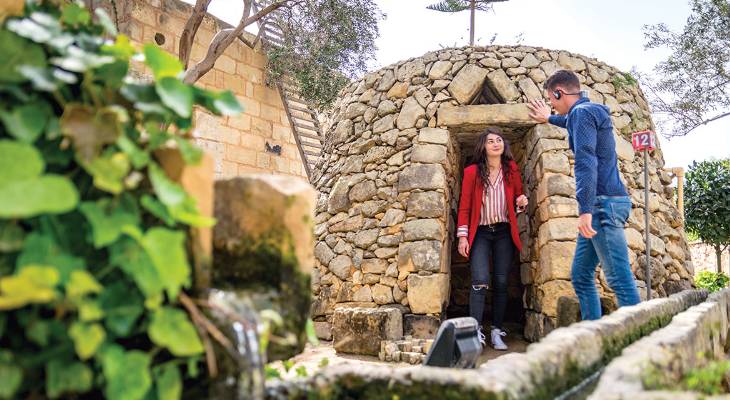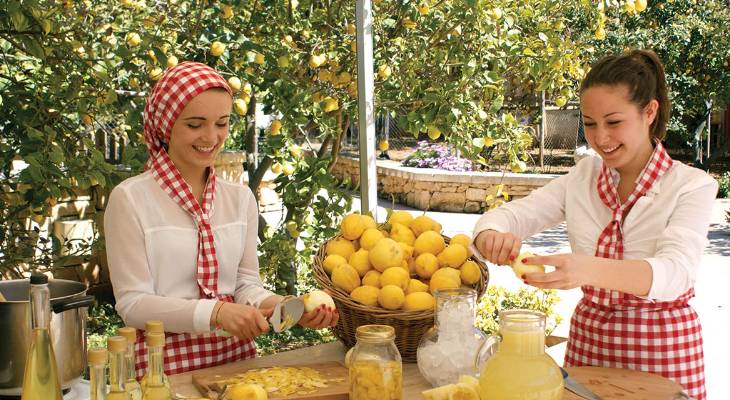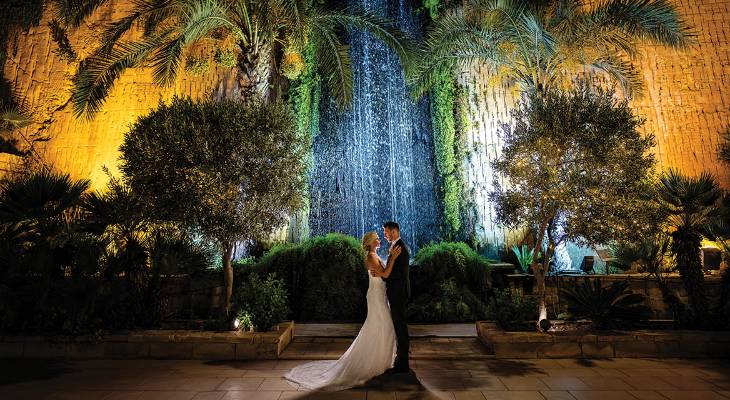Eve Baldacchino, General Manager of the family-run The Limestone Heritage, speaks to Rebecca Anastasi about the stone’s enduring significance, the museum’s role in celebrating Maltese customs and the family legacy behind their work.
Look around you, and it’s impossible to ignore the deep yellow of Malta’s stonework, weathered by the salt of the Mediterranean Sea. It’s almost as if the buildings’ façades have absorbed the warmth of the sun – the same warmth that flushes the skin.
“Some of the islands’ oldest as well as most remarkable sites – ranging from prehistoric temples to modern-era heritage buildings – are all made of limestone, Malta’s only natural resource,” says Eve Baldacchino, the General Manager of The Limestone Heritage. “The stone has provided the building blocks for such iconic sights as Mdina and Valletta, our capital city. The Limestone Heritage celebrates this, and we’re often the first stop for anyone wanting to understand the material’s vital role in Malta’s history – and why preserving and restoring it is essential for future generations.”

The museum is the country’s only one dedicated to the golden stone of the islands – officially known as Globigerina Limestone or Franka in Maltese – which has been used across the archipelago since the earliest known settlements. “In Malta, we have construction dating from 5,000BC that already uses this material, so it’s vital for us to preserve it and ensure its significance is recognised. Ultimately, all of Malta’s most important cultural landmarks have been sculpted with this stone.”
For Eve, celebrating Malta’s honey-combed building blocks is part of a family tradition. Her grandfather once led the now-defunct Quarry Owners Association of Malta, running several quarries through the 1970s and ‘80s. Eve’s father, Emanuel Baldacchino, inherited and took over the site in the ‘90s, toiling in the quarry in rain, shine or sweltering heat. However, his work digging stone was not to last. “Unfortunately, due to health reasons, my father was advised by his doctors to stay out of the sun – but he was always so active and felt he had to do something. Soon after, in 1998, we went on a family holiday where my father raised the idea of transforming the quarry into a tourist attraction. So, that’s what he did.”
Emanuel’s entrepreneurial spirit galvanised him into action, and he started working on his project as soon as the family returned from the trip. It took four years to transform the quarry and on 5th May 2002, The Limestone Heritage was officially inaugurated, with a prime focus on showcasing the uses, methods and cultural impact of Malta’s limestone to visitors.
Today, it’s a family affair, with Eve having started working with her parents and sibling when she was only 15. “Twenty-three years later, and I’m still here,” she laughs. “My brother (Operations Manager, Julian Baldacchino) and I were raised to be part of this. And we continue to build on the original mission of celebrating the islands’ natural resources.”
The guest experience has been curated with this end in mind. “When guests arrive, we typically start the tour with a short ten-minute film introducing them to the political, economic and cultural significance of limestone in Malta. We then offer an audio-guided tour through our indoor museum, which features authentic and original quarrying tools used across different historical periods on the Maltese islands. We also showcase how quarries used to be dug by hand, and when machinery was added to the process,” Eve explains.
Visitors are then guided through a replica of a typical Maltese farmhouse. “This boasts distinctive features typical of a limestone structure – for example stone arches, known as ħnejjiet in Maltese. We’ve also included other traditional details, such as a fuklar – a Maltese stone cooker – and the barumbara – pigeonholes – that can be seen in many farmhouse constructions – and finally, a manger, the home of our farm animals,” Eve continues.

The tour typically ends with a visit to the studio where live stonework demonstrations are held by the museum’s craftsmen. “We even offer our guests the chance to make their very own souvenir,” Eve says. “We give them a piece of limestone, and our craftsmen guide them in creating a little memory of the visit, before heading outside to the garden, the citrus grove or to view the waterfall.”
There are also limoncello and olive oil tastings, using products from the farm harvested by the family. “Every year, we cultivate our own olives and produce our own olive oil; we don’t sell to any other shops, but we do make some bottles available to our guests for tasting sessions. We also make our own limoncello using the lemons and oranges harvested in our grove; thankfully, our trees produce many lemons, so this an offering that’s fresh and homegrown. And, if the weather is nice, we organise the tasting sessions outside in our garden – it’s truly a beautiful experience,” Eve smiles.
The museum is not only a celebration of Malta’s stone but, within its very walls, lie the remnants of Maltese traditions upheld by dozens of previous generations – and the citrus grove is one such example. “When the quarry upon which The Limestone Heritage now stands started to become disused in the 1980s, my parents began to plant citrus trees. This was typical of how these sites used to be regenerated over the centuries. Citrus trees need a lot of sun and shelter from the winds, and that’s exactly what old quarries could provide – so they were often transformed into citrus groves.”
Over the years, The Limestone Heritage has widened its scope and now also offers the site as a venue for luxury weddings – with the waterfall as a background – as well as gala dinners, destination events, and corporate outings. Not satisfied with resting on their laurels, Eve confirms the opening of a new restaurant towards the latter half of 2025.
Elaborating on some of the visitors’ feedback, Eve asserts that “the waterfall garden always takes our guests’ breath away. It’s really got that ‘wow’ factor. And we do get many couples – mainly from the UK, but also from Australia, the US, Nigeria, and India – choosing to get married here. We’re very versatile and the space can be used like a blank canvas to create any mood, style or function, whether that’s stand-up events or sit-down meals, a wedding, a birthday or even a Holy Communion celebration. We also have a marquee, as weather cover. The place sells itself, but we’re also very open to our guests’ needs,” the General Manager explains.
Eve also sees the role of The Limestone Heritage as one bound to Malta’s future – not only to its past or present. “Malta is a small island and this resource is limited: you keep cutting into the land and, at one point, you’ll realise there’s nowhere left to quarry. Nowadays, there are only a few sites in operation – perhaps, around 10 or 12, compared to over 100 in the 1970s. As a result, many construction companies have shifted to using concrete blocks – putting the island’s unique architectural character at risk. Moreover, limestone is a soft material; it’s easy to work with, but it erodes quickly, which means it requires constant attention.”

Shane P Watts
With this knowledge, The Limestone Heritage is working with stakeholders to keep the limestone trades and material alive, relevant and in circulation. “We try and communicate that when, for example, you are demolishing an old Maltese farmhouse, you need to take it down brick by brick – otherwise that stone will be unusable. It’s more costly to take such care, so, sometimes, when we find out that one of these structures is going to be demolished, we intervene to try to save the stone and store it. The more we preserve it, the better,” she continues.
Eve is energised by her role and by the people she meets. “Getting to know people from all over the world is a privilege. I mostly handle the weddings side of the business, and every single couple’s special day is different. No wedding is the same, and it’s a joy to be able to play such a vital role in making people’s experiences special. However, I also love speaking to our visitors when they come and see the attraction, take the tour or even participate in one of our tasting sessions. To hear about the memories they will keep of this place is exciting and drives us to keep getting better,” she smiles, concluding.
The Limestone Heritage, Park and Gardens,
Mons. M. Azzopardi Street, Siġġiewi.
www.limestoneheritage.com
This article first appeared on Guide Me 2025.